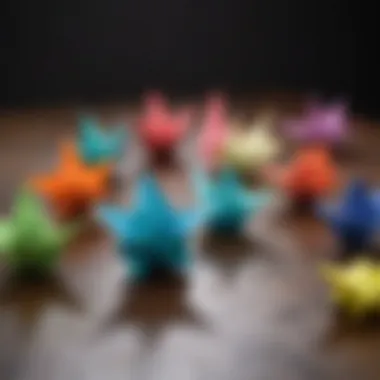Exploring the Art and Science of Origami


Intro
Origami is often perceived as a simple craft, yet it embodies a profound intersection of art and science. It challenges the mind while stimulating creativity, offering a unique blend of visual appeal and intellectual engagement. The pursuit of folding paper into intricate designs has a history rich in culture, evolution, and technical prowess.
As you delve into this article, you'll discover the various dimensions of origami—from its historical roots to its contemporary applications across multiple sectors. This exploration not only underscores the aesthetic and tactile experience of origami but also its relevance within fields such as education, engineering, and medicine.
The discussion will reveal how these folded creations are more than mere decorations. They hold the potential for cognitive development and innovation in problem-solving, thus affirming origami's position as both an artistic expression and a scientific endeavor.
Intro to Origami
Origami is more than just the art of folding paper; it encapsulates a rich tradition that weaves together creativity, mathematics, and culture. Understanding origami is essential not only for appreciating its aesthetic beauty but also for recognizing its applications in various scientific fields. The importance of origami lies in its ability to bridge disciplines, offering insights that extend well beyond art.
Definition and Overview
Origami originates from the Japanese words "oru" (to fold) and "kami" (paper). It involves the manipulation of a single sheet of paper into a multitude of designs without cutting, gluing, or tearing. Many people perceive origami simply as a form of children's craft. However, its potential reaches into architecture, robotics, and even medical devices. Artists often create intricate models representing animals, plants, or geometric shapes, but the true essence of origami lies in its principles and structures.
Historical Development
Origami's roots can be traced back centuries. Although the earliest records appear in Japan, it is likely that similar paper-folding practices existed in ancient China. The first known origami book, "Senbazuru Orikata," was published in the 18th century. It detailed the folding techniques necessary for creating a thousand origami cranes, which symbolize peace and hope. Over the years, the practice has evolved, with contemporary origami artists experimenting with innovative forms, thereby enriching this enduring tradition.
Cultural Significance
In many cultures, origami serves significant roles beyond personal expression. It has been used in various ceremonies, such as weddings and funerals, to signify blessings or farewells. In Japan, origami is integrated into educational systems, often taught to children as a means of enhancing fine motor skills and fostering creativity. The art also resonates deeply with concepts of nature, harmony, and respect, reflecting deeper philosophical ideas.
"Origami, as an art, symbolizes the transformation of the ordinary into something extraordinary, highlighting both creativity and discipline."
The cultural impact of origami is evident in its worldwide acceptance, influencing various art forms. Artists like Robert Lang and Eric Joisel have garnered international attention, showcasing how origami can be both an art and a science.
The Mathematical Foundations of Origami
The study of origami extends beyond mere artistic endeavors; it intersects significantly with mathematics. Understanding the mathematical foundations of origami reveals the logic underlying intricate folds and shapes. This section emphasizes the importance of geometry, theorems, and topology in origami. By exploring these elements, one gains not just appreciation for the craft, but also insight into problem-solving strategies applicable in various fields.
Geometry in Origami
Geometry serves as the backbone of origami. The very act of folding paper invokes geometric principles. Every crease creates an angle, and each fold can be seen as a geometric transformation. Here are several critical geometric concepts:
- Basic Shapes: Many origami models start with simple geometric forms such as rectangles or squares. The properties of these shapes guide the folding process.
- Symmetry: Many origami designs rely on symmetry, which helps in visualizing the final form. For instance, if one side of a design is folded, the other side often mirrors that fold.
- Angles and Proportions: Precision in angles is critical. A slight change in the angle can lead to a significantly different outcome, illustrating the importance of careful calculations.
Through the lens of geometry, origami becomes a study in spatial awareness and creativity, illustrating how mathematical concepts manifest in physical form.
Origami Theorems
Several theorems play a pivotal role in origami, providing a theoretical framework for understanding folding techniques. Noteworthy are the following:
- Maekawa's Theorem: This theorem addresses the number of valleys and mountain folds in a flat origami design. Understanding this relationship can guide creators in structuring their models effectively.
- Kawasaki's Theorem: It aids in determining whether a flat origami model can be folded into three dimensions without overlaps or complications. The theorem revolves around the concept of angles at the crease.
- Huzita-Hatori Axioms: A set of axioms defines the allowable folds. These axioms establish a concrete framework within which any origami construction can be outlined mathematically.
These theorems provide not only rules for operation but open pathways for new discoveries within the realm of origami, merging art and mathematics seamlessly.
Topology and Origami
Topology introduces a different perspective where the focus is on properties preserved through deformations, twistings, and stretchings of materials. In the context of origami:


- Surface Properties: Origami is fundamentally about manipulating surface area. Topological properties allow for the exploration of how surfaces can be folded without cutting.
- Connection to Algorithms: Many origami designs can be analyzed using topological methods, linking it to computer algorithms that can design new models or solve complex folding problems.
- Non-Euclidean Concepts: Origami can extend into non-Euclidean realms, exploring how folds can create unusual, non-flat geometries.
This intersection of topology and origami opens avenues for innovative applications, particularly in engineering and materials science. The understanding gained through these principles enhances the practical application of origami in multiple disciplines, showcasing how mathematical foundations can elevate artistic practice.
Techniques in Origami
Understanding techniques in origami is essential for grasping both the fundamental and advanced aspects of this intricate art form. The techniques encompass a range of skills and approaches critical to transforming a simple sheet of paper into complex figures. Mastering these techniques not only brings satisfaction but also enhances creativity and cognitive abilities.
Basic Folding Techniques
Basic folding techniques serve as the foundation for origami practice. They include fundamental folds such as the valley fold, mountain fold, and reverse fold. Mastering these foundational skills allows practitioners to construct simple models effectively.
- Valley Fold: This fold creates a V-shape and is often the starting point for many origami designs. To perform a valley fold, the paper is folded towards oneself.
- Mountain Fold: The opposite of the valley fold, it forms a peak. Here, the paper is folded away from the user.
- Reverse Fold: This fold turns a pre-creased line of the paper in the opposite direction. It is crucial in shaping the final model.
These basic folds not only initiate the paper transformation process but also facilitate a deeper understanding of complex structures. Practicing these techniques helps develop muscle memory, allowing for smoother transitions to more complex origami designs.
Intermediate Techniques
Once the basics are in place, artists can explore intermediate techniques. These methods typically incorporate the basic folds to create more complex figures and shapes. Techniques like pleating, sink folding, and twisting become relevant at this stage.
- Pleating: This involves creating multiple parallel folds which can add texture or structural support to a design. Successful pleating allows the origami model to have depth and dimension.
- Sink Fold: This technique requires folding a section of paper into the model itself, creating an intricate look while maintaining form. It is often used to refine edges.
- Twisting: As the name suggests, this involves twisting portions of the paper to achieve desired angles and curves.
Mastering these techniques fosters a better understanding of how different folds interact, leading to increasingly complex designs and forms.
Advanced Origami Methods
Advanced origami methods represent the pinnacle of paper folding skills. These techniques often engage mathematical and geometric concepts, allowing artists to create intricate designs like modular origami and origami tessellations. They require a high level of precision and patience but yield stunning results.
- Modular Origami: This involves creating multiple units which are then assembled to form a single larger model. Each unit must fit together precisely, representing a significant challenge.
- Tessellation: This method consists of repeating patterns of folds to create visually striking models that can appear three-dimensional, like intricate geometric designs on a plane.
- Wet Folding: A technique that uses damp paper, allowing for softer curves and more organic shapes. This is particularly valuable for creating lifelike animal models.
Achieving proficiency in these advanced methods elevates an artist's ability and opens new creative possibilities. Not only does it emphasize skill but it also sparks a deeper appreciation for the intersection of art and science within origami.
"Origami is both a science and an art, requiring an understanding of geometry while allowing for personal expression through design."
Engaging with these various techniques leads to a more comprehensive appreciation of origami. Each technique contributes toward an understanding of not just the models themselves, but also the broader implications of structure and creativity in the art form.
Origami in Education
Origami is often seen as an engaging art form, yet its potential as an educational tool is substantial. This section examines the integration of origami into educational frameworks and how it contributes to cognitive and creative development. By utilizing origami, educators can foster skills such as problem-solving, spatial awareness, and fine motor coordination in students.
Cognitive Development and Learning
Engaging in origami has notable cognitive benefits. The folds and designs require students to follow sequential instructions, enhancing their ability to process information. As students learn how to create shapes, they connect theoretical concepts in geometry and symmetry to practical applications. Additionally, origami encourages critical thinking as students diagnose errors in their folding techniques and make adjustments accordingly. It promotes a growth mindset, as learners realize that persistence leads to improved skills and outcomes.
Integrating Origami into Curricula
Incorporating origami into various subjects can enhance learning experiences. For instance, math classes can integrate origami to teach geometric properties and angles. Science lessons explore concepts in biology or engineering, using origami to model structures found in nature or applications in design. Art classes can focus on the aesthetic aspects of origami, allowing students to express their creativity while learning about cultural significance.
To successfully integrate origami into curricula, teachers can:
- Develop lesson plans that connect origami to core subjects.
- Provide resources such as online tutorials or origami paper kits.
- Encourage collaborative projects where students work in groups to create larger origami displays.


Evidence-based Outcomes
Research supports the efficacy of origami in enhancing academic performance. Studies have shown that students who participate in origami activities demonstrate improved spatial reasoning skills and better engagement in class.
"Engagement in hands-on activities like origami can significantly boost both cognitive and emotional development in students."
Furthermore, the tactile nature of origami helps students with learning disabilities or those requiring additional support, as the physical act of folding can aid memory retention and understanding. Educators note that students often display increased confidence and collaboration when working on origami projects.
In summary, origami is more than just an art form; it serves as a significant educational tool that supports cognitive development and enhances various subjects. By integrating origami into curriculums, educators can provide enriching experiences that appeal to students' creativity while reinforcing valuable skills.
Applications of Origami
Origami is not just a form of artistic expression; it has practical applications that extend into various fields including engineering, medicine, and robotics. These applications stem from its unique folding techniques which allow for efficient use of materials and creative problem-solving. Exploring these applications reveals a deeper understanding of how origami can influence and innovate numerous industries. The importance of these applications lies in their ability to bridge practical utility and artistic creativity, fostering advancements in both technology and design.
Origami in Engineering
In engineering, origami principles can be seen in designs that require efficient use of space and materials. One prominent example is the development of deployable structures. These structures can be folded down to a compact size and unfolded into larger forms. This is particularly useful in aerospace engineering, where space is at a premium, such as in satellite technology.
Engineers utilize origami techniques to create structures that can withstand diverse environmental conditions while maximizing material efficiency. The design of solar panels that unfold into larger arrays is one instance where origami principles are applied effectively. This method not only saves space during launch but also optimizes performance once deployed in orbit.
Medical Innovations
Origami also finds its way into the medical field, especially in minimally invasive procedures. Surgeons increasingly rely on origami-inspired devices to deliver surgical tools and materials within the body through small incisions. For instance, origami-based stents can expand to facilitate blood flow without requiring extensive surgical intervention.
Furthermore, researchers are exploring origami techniques for creating better drug delivery systems. Using folds, they can design carriers that release medication at controlled rates, improving the efficacy of treatments. The nature of origami allows for designs that can adapt to various medical challenges, representing an innovative fusion of art and science.
Robotics and Origami
The field of robotics is undergoing significant transformation through the integration of origami techniques. Origami can inspire soft robotics, where robots made of flexible materials mimic the folding and unfolding patterns of origami models. These robots have diverse applications, such as in search-and-rescue missions where adaptability is crucial.
For example, by implementing origami folding patterns, researchers have developed robots capable of navigating confined spaces. Such designs allow for efficient movement and transformation in complex environments. These advanced robotics not only reflect the aesthetic aspects of origami but also highlight its potential for innovative solutions in real-world challenges.
"The application of origami extends far beyond art, reshaping industries like medicine, engineering, and robotics to meet modern challenges."
The Psychological Benefits of Practicing Origami
Origami, often viewed merely as a delicate art form, carries profound psychological advantages. Engaging in this intricate craft goes beyond folding paper; it cultivates mental skills and emotional health. Understanding the psychological benefits can help individuals embrace origami as a tool for better cognitive functioning, creativity, and emotional wellness.
Enhancing Focus and Concentration
Practicing origami requires precision and attention to detail. Each fold demands focus, which naturally leads to improved concentration skills. Studies suggest that activities needing fine motor skills boost cognitive functions, making origami an excellent exercise for the mind.
- While folding, distractions are minimized. The intricate steps required engage the brain, allowing it to operate in a focused state.
- This process can improve overall attention span over time. For students or professionals, enhanced concentration can translate into better learning and productivity.
Fostering Creativity
Origami is a unique blend of structure and artistry. While it adheres to specific folding techniques, it also invites creativity. Practitioners often explore new designs and methods, which can fuel imaginative thinking.
- Engaging in origami allows individuals to express themselves in a tactile way. It promotes risk-taking in a controlled environment, encouraging artists to experiment.
- The nature of origami can lead to innovative problem-solving skills. By finding new ways to create, individuals expand their creative thought processes.
Stress Relief and Mindfulness


The repetitive motions involved in origami can induce a meditative state. Many find that folding paper helps alleviate stress and promote mindfulness.
- The focus required takes attention away from daily pressures. This allows a mental reset, fostering relaxation.
- Creating art through origami can serve as a form of therapy. People report a sense of achievement and calmness upon completing a piece.
"Engaging in activities like origami can transform the mind into a place of peace and tranquility." - Mental Health Research Journals
In summary, origami provides significant psychological benefits. Enhancing focus, fostering creativity, and offering stress relief are all key aspects. For educators, students, and professionals, recognizing these advantages can transform origami from a recreational activity into a valuable tool for cognitive and emotional growth.
Origami and the Environment
The intersection of origami and the environment reveals a profound understanding of sustainability and creativity. Origami, traditionally seen as an art form, also holds immense potential for positive environmental impact. This section elucidates how origami practices can leverage sustainable materials, contribute to environmental art initiatives, and play a role in waste reduction.
Sustainable Materials in Origami
The choice of materials in origami is critical for its environmental impact. Using sustainable materials not only reduces waste but also promotes awareness about ecological issues. Traditionally, origami used paper, which can be recycled. Now, many artists and designers are exploring alternatives such as
- Recycled Paper: This minimizes the need for new raw materials, reducing deforestation and energy consumption.
- Plant-Based Plastics: These materials are biodegradable, offering an eco-friendly option without sacrificing folding integrity.
- Natural Fibers: Fabrics like cotton and silk can offer unique textures while remaining sustainable if produced ethically.
Opting for these materials not only enhances the aesthetic of the finished piece but also aligns the practice with global sustainability efforts.
Environmental Art Initiatives
Origami as an environmental art initiative serves a dual purpose: it beautifies spaces while raising awareness about ecological issues. Artists have begun to create large-scale origami installations that engage communities and provoke thought regarding conservation.
Some examples include:
- Origami for the Ocean: Projects that use origami whale or fish models to highlight the plight of marine life due to pollution.
- Public Art Installations: Origami displays in parks or urban areas to draw attention to local environmental concerns fosters community engagement.
- Workshops and Collaborations: Through educational workshops, artists encourage participants to explore sustainability through art, creating a ripple effect in awareness and action.
These initiatives contribute not only to artistic spaces but also implore individuals to engage with their environment more mindfully.
Waste Reduction through Origami
Origami can significantly contribute to waste reduction in various ways. The precision and thoughtfulness required in origami encourage mindful production processes.
Key aspects include:
- Minimal Material Use: Origami often requires only a single sheet of paper, limiting excess and promoting careful planning in design.
- Upcycling Materials: Artists often utilize scrap paper and packaging. This not only reduces waste but also transforms ordinary materials into intricate art.
- Educational Tools: Origami serves as a tool in schools to teach students about resource management and the importance of reducing waste, thereby positively influencing future generations.
Culmination: The Future of Origami
As we look ahead, the future of origami presents numerous opportunities and challenges across different disciplines. This conclusion wraps up our exploration of origami, emphasizing its evolving role in technology, education and beyond. Understanding the importance of origami in modern contexts reveals not just its artistic value, but also its potential for innovation and practical applications.
Advancements in Technology
One significant aspect of the future of origami is the technological advancements that continuously reshape the field. Innovations in computational design have led to new ways of folding and creating complex structures. For instance, researchers are utilizing algorithms to automate the folding process, which allows highly intricate designs to be achieved with precision. Moreover, 3D printing technologies are increasingly integrated with origami principles. This combination can fabricate objects that are more versatile and efficient, significantly altering industries such as manufacturing and construction.
Origami's algorithms are also finding use in robotics. By mimicking the folding techniques, engineers design more adaptable and efficient machines that can transform in real time.
Origami Beyond Art
Origami is transitioning from a traditional art form to a multifaceted tool in various fields. Its applications are encapsulated both in practical solutions and educational strategies. For instance, origami principles are making inroads into architecture. Origami-inspired designs can create structures that are not only aesthetically pleasing but also environmentally friendly. The folded structures tend to use less material and offer unique design capabilities.
In the educational sphere, origami is now recognized as a vital tool for teaching mathematics and spatial reasoning. Schools are increasingly adapting origami into their curricula to help students engage with concepts of geometry, providing a hands-on approach to learning. This method promotes problem-solving skills and enhances cognitive development.
Final Thoughts
As we examine where origami is headed, it's reasonable to forecast continued interest and integration of this age-old art into contemporary society. The movement towards sustainability in material choices aligns well with origami's inherent nature of transforming a single sheet into a masterpiece without waste.
"Origami embodies a perfect synergy of art and science, showcasing the brilliance of human creativity."







